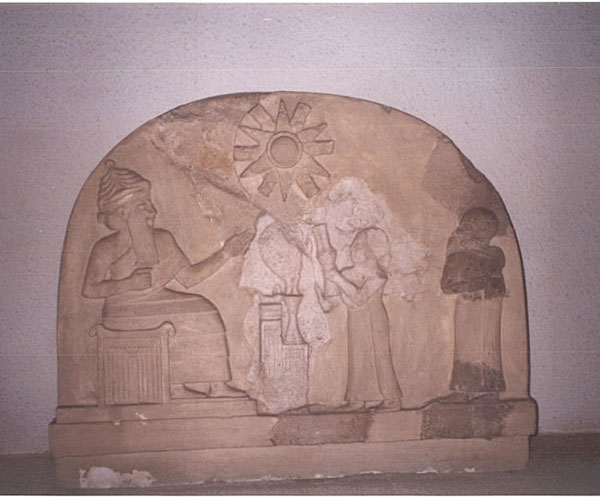


An, Anum ou Anu, le roi juste mais lointain. Anu n'intervient pratiquement jamais seul dans les affaires humaines. Il est le principal de la triade suprême, composée aussi d'Enlil et d'Ea, qui est responsable de la création du monde.
An (Anou), dieu du Firmament était le dieu protecteur d'Ourouk, la première ville dédiée à son culte. A l'aube des temps, il semble avoir été considéré comme le chef du Panthéon. Son nom signifiait "cieux" et son symbole était une étoile. Par la suite, il allait s'enfoncer dans l'ombre et abandonner sa position dominante.
Avec Enlil et Ea, Anu forme la triade des grands dieux et leur oeuvre est commune.
Lorsque Anu, Enlil et Ea eurent une première idée du ciel et de la terre, ils trouvèrent un moyen habile de pourvoir à la subsistance des dieux. Ils se construisirent dans le pays une demeure agréable et les dieux s'installèrent dans cette demeure, leur temple principal. Ensuite, ils remirent au roi le soin de leur assurer des revenus réguliers de choix et, pour le régal des dieux, établirent l'obligation alimentaire. Ainsi, instituèrent-ils leur mainmise sur ce qui est devenu le pays principal des hommes.
Le culte de Anu ne se limitait pas à Uruk, il avait aussi des temples à Deir, à Assur et à Adad.
Dans la totalité aquatique des débuts du monde apparait un premier couple divin, Apsou et Tiamat. Ensuite viennent d'autres couples, Lakhmou et Lakhamou, Anshar et Kishar. Puis naissent Enlil et Anu, le dieu du ciel, qui à son tour engendre Ea. Anu est le premier dans le temps et dans l'espace.
Si nous regardons les différentes tablettes représentant les dieux de Sumer, nous constatons qu'il y a une nette disproportion entre les dieux représentés et les personnages présents. Si nous mettons les dieux debout, ils seront nettement plus grands que les autres personnages, ce qui m'amène à cette réflexion : si les dieux sont dessinés ou gravés plus grand est-ce pour leur donner plus d'importance ou le ou les dieux étaient-ils réellement plus grands ce qui reviendrait à confirmer qu'à une époque plus reculée les "géants" ont bien existé et qu'ils étaient considérés comme des dieux.


Year, Anum or Anu, the king, but just far away. Anu does almost never alone in human affairs. It is the principal of the supreme triad, composed also of Enlil and Ea, which is responsible for the creation of the world.
An (Anu), god of the firmament was the patron god of Uruk, the first city dedicated to his worship. At the dawn of time, it seems to have been considered the leader of the Pantheon. Its name means "heaven" and its symbol was a star. Later, he would sink into the shadows and give up its dominant position. With Enlil and Ea, Anu form the triad of great gods and their work is common.
When Anu, Enlil and Ea had a rough idea of heaven and earth, they found a clever way to provide for the sustenance of the gods.
They were built in the country remains a pleasant and gods moved into this house, their main temple. Then they gave the king the care of their regular income to ensure choice and, to the delight of the gods, established the support obligation. Thus, they instituted their grip on what has become the main country of men.
The cult of Anu was not limited to Uruk, he also had temples at Deir at Assur and Adad.
In all aquatic beginnings of the world appears the first divine couple, Apsu and Tiamat. Then there are other couples, and Lakhmou Lakhamou, and Anshar Kishar. Then Anu and Enlil are born, the god of the sky, which in turn generates Ea. Anu is the first in time and space. If we look at the various bars representing the gods of Sumer, we find that there is a clear disproportion between the gods and characters represented in attendance.
If we stand the gods, they will be significantly larger than the other characters, which brings me to this thought: if the gods are drawn or engraved more is it to give them more important or whether the gods Were they really the biggest which would amount to confirm that an earlier period the "giants" did exist and were considered gods.
